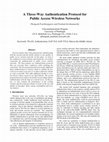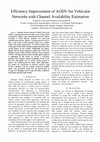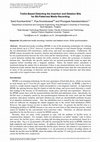Papers by Phongsak Keeratiwintakorn
Telemedicine is a future trend of medical care due to the increasing cost of treatment and the ag... more Telemedicine is a future trend of medical care due to the increasing cost of treatment and the aging of population around the World. Several telecommunication technologies are proposed for transferring medical data between a point of care and a hospital. However, it does not provide full mobility where a patient still needs to be attached with wired monitoring devices. In this paper, we proposed a wireless three-lead electrocardiogram (ECG) device using a mote-based Wireless Sensor Network (WSN) to transfer heart signals from a patient to a personal computer for monitoring and storing. Our proposed device augments the mote-based Telos node and TinyOS. The experiment results show the similarity of the ECG signals between our three-lead wireless ECG device and a wired commercial ECG device.

2008 SICE Annual Conference, 2008
Telemedicine is a future trend of medical care due to the increasing cost of treatment and the ag... more Telemedicine is a future trend of medical care due to the increasing cost of treatment and the aging of population around the World. Several telecommunication technologies are proposed for transferring medical data between a point of care and a hospital. However, it does not provide full mobility where a patient still needs to be attached with wired monitoring devices. In this paper, we proposed a wireless three-lead electrocardiogram (ECG) device using a mote-based Wireless Sensor Network (WSN) to transfer heart signals from a patient to a personal computer for monitoring and storing. Our proposed device augments the mote-based Telos node and TinyOS. Our device is designed using low-cost, low-power components, and it provides full mobility to a patient by eliminating noise due to patient's movement. The experiment results show the similarity of the ECG signals between our three-lead wireless ECG device and a 12-lead wired commercial ECG device.
2007 Asia-Pacific Conference on Communications, 2007
By using a sleep schedule technique, S-MAC can reduce the energy consumption in a wireless sensor... more By using a sleep schedule technique, S-MAC can reduce the energy consumption in a wireless sensor network; thus, breaking the network into a virtual cluster. Using a different sleep schedule in each cluster causes problems in the S-MAC protocol. This paper aims to investigate the appropriate cluster size for the wireless sensors networks (WSNs) in terms of the average node number per virtual cluster. This is to show the effect of cluster size on the network performance parameter such as latency and energy consumption. The experiment results are obtained using the NS-2 simulator.
2007 7th International Conference on ITS Telecommunications, 2007
This research proposes the methodology of detection and estimation of road congestion using cellu... more This research proposes the methodology of detection and estimation of road congestion using cellular phones. We survey the road that is well-known as one of the most congested roads in Bangkok, Thailand. In our survey, we collect two kinds of information, Cell Dwell Time (CDT) using a cellular phone and velocity and position using Global Position System (GPS). To categorize CDT according to Cell Coverage Area (CCA), we have also collected Local Area Code (LAC) and Cell ID. We collect data into "Green" survey and "Red" survey, and analyze the data using two models: Junction model and Link model. The results have shown that there is significant difference between the two surveys. However, the accuracy of traffic flow estimation is tentatively decreased as the CCA size is decreased.

Journal of Natural Gas Chemistry, 2012
Recently, Fischer-Tropsch synthesis (FTS) has become an interesting technology because of its pot... more Recently, Fischer-Tropsch synthesis (FTS) has become an interesting technology because of its potential role in producing biofuels via Biomassto-Liquids (BTL) processes. In Fischer-Tropsch (FT) section, biomass-derived syngas, mainly composed of a mixture of carbon monoxide (CO) and hydrogen (H 2 ), is converted into various forms of hydrocarbon products over a catalyst at specified temperature and pressure. Fixed-bed reactors are typically used for these processes as conventional FT reactors. The fixed-bed or packed-bed type reactor has its drawbacks, which are heat transfer limitation, i.e. a hot spot problem involved highly exothermic characteristics of FT reaction, and mass transfer limitation due to the condensation of liquid hydrocarbon products occurred on catalyst surface. This work is initiated to develop a new chemical reactor design in which a better distribution of gaseous reactants and hydrocarbon products could be achieved, and led to higher throughput and conversion. The main goal of the research is the enhancement of a fixed-bed reactor, focusing on the application of Kenics TM static mixer insertion in the tubular packed-bed reactor. Two FTS experiments were carried out using two reactors i.e., with and without static mixer insertion within catalytic beds. The modeled syngas used was a mixed gas composed of H 2 /CO in 2 : 1 molar ratio that was fed at the rate of 30 mL(STP)·min −1 (GHSV ≈ 136 mL·g −1 cat ·h −1 ) into the fixed Ru supported aluminum catalyst bed of weight 13.3 g. The reaction was carried out at 180 • C and atmospheric pressure continuously for 36 h for both experiments. Both transient and steady-state conversions (in terms of time on stream) were reported. The results revealed that the steady-state CO conversion for the case using the static mixer was approximately 3.5 times higher than that of the case without static mixer. In both cases, the values of chain growth probability of hydrocarbon products (α) for Fischer-Tropsch synthesis were 0.92 and 0.89 for the case with and without static mixer, respectively.

Several schemes have been proposed for authenticating both the network and the mobile stations to... more Several schemes have been proposed for authenticating both the network and the mobile stations to one another in public access wireless networks. In this paper, we look at the weaknesses of such schemes and enumerate a set of four constraints for authentication in public access wireless networks. We then propose two authentication protocols that can overcome these weaknesses while satisfying the constraints. The first proposed protocol provides additional direct authentication to wireless clients to validate the network access point to prevent or to detect malicious attacks as early as possible. This adds additional burden to wireless devices whose resources are often limited. The second proposed protocol reduces the burden by providing indirect authentication with the help of a trusted server. In this paper, we also evaluate the performance of the existing schemes and the proposed schemes in terms of the size and number of messages, delay, energy consumption and security features.

Wireless communication becomes important part of everyday life, and in the future, there will be ... more Wireless communication becomes important part of everyday life, and in the future, there will be new wireless technologies. Vertical handoff between networks with different wireless network interface becomes so important especially in mobile devices that move at high speed such as vehicles. The vertical handoff is required for a vehicle to connect to different wireless networks for different purpose. For example, vehicles may connect to cellular network to send short messages such as news or email, and may connect to short range networks to acquire some localized information. In this paper, we investigate the possibility and the performance of using GSM/GPRS module as an interface to cellular networks and Zigbee module as an interface to short range networks. In our experiments, we set up both soft and hard handoff scenario to measure the packet round trip time and delay. From the results, it shows that the packet round trip time (RTT) in GPRS networks on the average is around 1 - 2...
2008 5th International Conference on Electrical Engineering/Electronics, Computer, Telecommunications and Information Technology, 2008
2008 5th International Conference on Electrical Engineering/Electronics, Computer, Telecommunications and Information Technology, 2008

The 8th Electrical Engineering/ Electronics, Computer, Telecommunications and Information Technology (ECTI) Association of Thailand - Conference 2011, 2011
Vehicular Ad-hoc Network (VANET) is the road vehicle's communication network without a base stati... more Vehicular Ad-hoc Network (VANET) is the road vehicle's communication network without a base station, which is proposed to utilize a link communication between vehicles according to IEEE 802.11p standard. For end-to-end communication between vehicles, a routing protocol is used to find a route based on link properties from one to another vehicle with specific requirements. In VANETs, vehicles move at high speed, which makes topology changed all the time, often causing failures in data transfer. Additionally, the failures happen when the signal congestion is high in the VANET; the efficiency of data transfer therefore decreases. Thus, routing in VANETs with high speed movement and high signal congestion is challenging. In this article, we present a cross-layer technique that calculates Channel Availability (CAV) at the link layer and applies CAV to AODV routing protocol to improve the communication for vehicle safety applications. We conduct our experiments on vehicular networks using NCTUns simulator with the realistic road-based mobility model. Our experiment results show the improvement on average TCP throughput and average UDP delay on different node density and data traffic density.

2011 International Symposium on Intelligent Signal Processing and Communications Systems (ISPACS), 2011
ABSTRACT Vehicular Ad-hoc Network (VANET) is the road vehicle's communication network wit... more ABSTRACT Vehicular Ad-hoc Network (VANET) is the road vehicle's communication network without a base station. For end-to-end communication between vehicles, a routing protocol is used to find a route based on link properties from one to another vehicle with specific requirements. In VANET, vehicles move at high speed, which makes topology changed all the time, often causing failures in data transfer. Additionally, the failures happen when the signal congestion is high in the VANET; the efficiency of data transfer therefore decreases. Thus, routing in VANET with high speed movement and high signal congestion is challenging. In this article, we present AODV-CAVM algorithm which including two mechanisms; first is using a cross-layer technique that calculates Channel Availability at the link layer; second is implementing mobility prediction based on neighborhood knowledge. We apply these mechanisms to modify AODV routing protocol to improve the communication reliability and latency for use in vehicle safety applications. We conduct our experiments on vehicular networks using NCTUns simulator with the realistic road-based mobility model. Our experiment results show that AODV-CAVM achieves better performance.
…, 2008
Abstract-Due to the high cost of fossil-based energy, several methods are proposed to reduce the ... more Abstract-Due to the high cost of fossil-based energy, several methods are proposed to reduce the usage of the energy in logistics and fleet management to be even more. GPS tracking system is a common approach to get vehicle location information in real-time for fleet planning. ...
The 13th IEEE International Symposium on Personal, Indoor and Mobile Radio Communications, 2002
Location aware services are becoming attractive with the deployment of next generation wireless n... more Location aware services are becoming attractive with the deployment of next generation wireless networks and broadband multimedia wireless networks especially in indoor and campus areas. To provide location aware services, obtaining the position of a user accurately is important. While it is possible to deploy additional infrastructure for this purpose, using existing communications infrastructure is preferred for cost reasons. Because of technical restrictions, location fingerprinting schemes are the most promising. In this paper we are presenting a systematic study of the performance/tradeoff and deployment issues. In this paper we present some experimental results towards such a systematic study and discuss some issues related to the indoor positioning problem.

IEEE Transactions on Magnetics, 2015
ABSTRACT Bit-patterned media recording (BPMR) is the promising technology to enhance an areal den... more ABSTRACT Bit-patterned media recording (BPMR) is the promising technology to enhance an areal density (AD) of hard disk drives beyond the limit imposed by the current perpendicular recording technology. Practically, a T -spaced equalizer is employed in a conventional (symbol-rate) BPMR system to shape the overall channel response to a target response before performing the data detection process, where T is a bit period. Because the BPMR channel response has a large excess bandwidth, we then propose to use a fractionallyspaced equalizer (FSE) in the oversampled BPMR system so as to improve the system performance. A design of the FSE and its corresponding one-dimensional and two-dimensional targets will be given. Thus, we compare the performance of the oversampled BPMR system with the symbol-rate one. Results indicate that the oversampled system performs better than the symbol-rate one in terms of bit-error rate (BER). Specifically, at BER = 10−4 and no media noise, the oversampled system can provide about 1 dB gain at the ADs of 2.0 and 2.5 terabit per square inch (Tb/in2) over the symbol-rate system. In addition, we found that the oversampled system is more robust to media noise than the symbol-rate one.

Bit-patterned media recording (BPMR) is one of the promising technologies for realizing an areal ... more Bit-patterned media recording (BPMR) is one of the promising technologies for realizing an areal density up to 4 Tb/in2; however, it poses new challenges to read channel design, including the two-dimensional (2D) interference, media noise, and track mis-registration. Furthermore, the BPMR system encounters the insertion, deletion and substitution errors, which are primarily caused by mis-synchronization between the write clock and the island positions. In this paper, we propose a novel detection method that exploits the trellis structure to detect the occurrence of insertion/ deletion bits. Specifically, the specific marker bits are inserted periodically inside an input data sequence before recording onto a magnetic medium. Hence, the branch metric calculation is monitored during the marker bits to determine if there is any insertion/deletion error in the system. Numerical results indicate that the proposed method can performs better than the conventional one in terms of the percent...
Vehicular Technology, IEEE Conference, 2004
Energy sayings are extremely important in wireless networks where devices operate using battery p... more Energy sayings are extremely important in wireless networks where devices operate using battery power. Security in wireless networks is also becoming crucial with the deployment of wireless local area networks in hot spot areas, organizations, hospitals and so on. Security protocols depend on energy consuming operations that occur in the cryptographic primitives used in the protocols. It has been observed

Proceedings of the 2003 International Conference on Machine Learning and Cybernetics (IEEE Cat. No.03EX693), 2003
A Military-based distributed interactive simulation (DIS) such as ModSAF has been used for many y... more A Military-based distributed interactive simulation (DIS) such as ModSAF has been used for many years. Several problems of the DIS-based simulation to support a large and heterogeneous virtual simulation environments have been discovered . To solve these problems, we propose an architectural multiagent-based framework to support a large military-based simulation with 3D visualization using inexpensive game simulators. Several software agents are used to support interoperability between DIS-based military simulation nodes and Unreal Tournament game simulators. An agent is used to reduce DIS traffic to efficiently utilize network bandwidth. It also performs protocol conversion between DIS protocol and a game engine protocol. Additionally, using a multi-agent system, our work is easily expandable to support several network environments and also to support agent-based intelligent operations. Our main contribution is twofold. We use a multi-agent system which is scalable to support our framework. In addition, our framework builds a simulation bridge that enables affordable high-quality 3D viewer node using affordable game simulations for military simulations.

SMC'03 Conference Proceedings. 2003 IEEE International Conference on Systems, Man and Cybernetics. Conference Theme - System Security and Assurance (Cat. No.03CH37483), 2003
Rapid advances in consumer electronics have led to the anomaly that consumer off the shelf (COTS)... more Rapid advances in consumer electronics have led to the anomaly that consumer off the shelf (COTS) gaming hardware and software now provide better interactive graphics than military and other specialized systems costing orders of magnitude more. UTSAF is bridging software written to take advantage of the power of gaming systems by allowing them to participate in distributed simulations with military simulators such as OneSAF which use the DIS protocol. UTSAF parses DIS PDUs and uses the information gained to control entities within the Unreal game engine using the Game-Bots modification. This paper describes the advantages of game engine based simulation and the UTSAF bridging and control architecture. Our main contribution is to build a simulation bridge that enables affordable highquality 3-D viewers for military simulations.

Lecture Notes in Computer Science, 2004
Energy efficiency has been an important factor in protocol design in wireless networks where smal... more Energy efficiency has been an important factor in protocol design in wireless networks where small handheld wireless devices rely solely on battery power. Security is also of great concern in wireless networks. Several security protocols adapted from wired networks have been used in wireless networks to provide identity authentication. Security protocols could contribute significantly to energy consumption, especially authentication protocols such as Wireless Transport Layer Security (WTLS) or Transport Layer Security (TLS) Handshake protocol that are based on computationally intensive public key cryptography. There have been many efforts trying to reduce cryptographic load and energy consumption at wireless devices. Some are complicated and others may not comply with existing WTLS/TLS standards. In this paper, we propose a simple variant of TLS Handshake protocol for mutual authentication and key exchange, which reduces energy consumption in wireless devices. The proposed protocol uses RSA and ECC algorithms differently to make the Handshake protocol more energy efficient. With our proposed protocol, we can save about 25% compared to 1024-bit RSA or 70% compared to 163-bit ECC Handshake protocol. Our proposed protocol can also be easily integrated into the standard WTLS protocol with small modification.

The 8th Electrical Engineering/ Electronics, Computer, Telecommunications and Information Technology (ECTI) Association of Thailand - Conference 2011, 2011
ABSTRACT th, phongsakk@kmutnb .ac.th Abstract -This paper focuses on Ad Hoc routing problems on I... more ABSTRACT th, phongsakk@kmutnb .ac.th Abstract -This paper focuses on Ad Hoc routing problems on IEEE 802.15.4 in which nodes' speeds and courses are different. The objective is to optimize the performance of the proactive OLSR routing protocol in terms of key metrics for real time services -End-to-End Delay and Throughput - within the selected stable-connectin g route, in terms of the number of link disconnection during a unit of time. The fuzzy heuristic probability is used as the key for routing metric. For validation purposes, the protocol is applied to compare to conventional OLSR algorithm, in terms of the minimum hop, and the fuzzy routing metric. Simulations are evaluated with focusing on the constant packet traffic within the realistic road mobility scenario. The simulation results show that the proposed algorithm approaches the significant performance improvement of the scenarios and metrics of interest. The contribution for this routing is for solving inter-vehicle communications, or V ANET routing problems.

Uploads
Papers by Phongsak Keeratiwintakorn